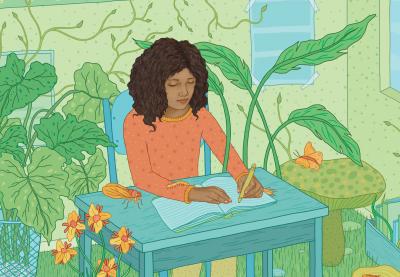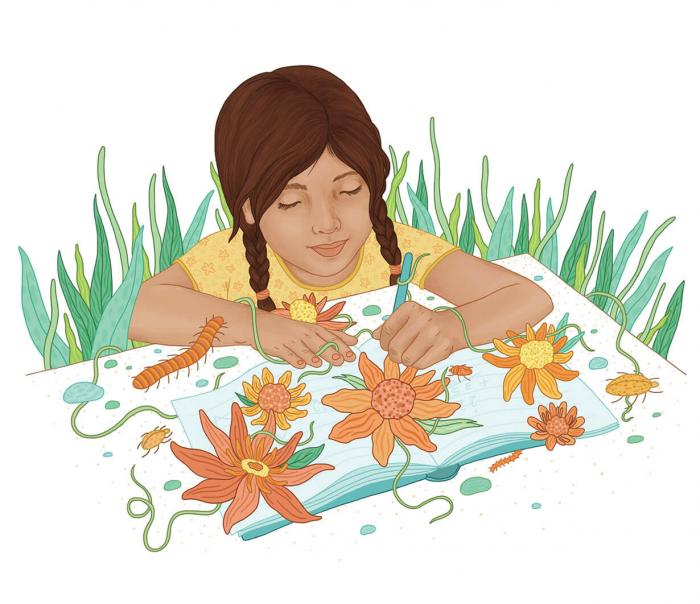Most of us remember a time from childhood when something in nature excited our sense of wonder. We may still carry with us treasured memories of playing in a creek or sitting on a concrete stoop from which we could see the clouds. Such experiences help shape who we are and how we view the world around us.
Unfortunately, many children today—especially those who live in urban areas—are growing up without opportunities for frequent, positive interactions with the natural world. A 2012 study by the Archives of Pediatrics & Adolescent Medicine found that only about half of preschoolers in the United States have daily parent-supervised outdoor play.
This deficit is affecting kids in unexpected ways. In his popular book Last Child in the Woods, Richard Louv wrote that children who grow up without close connections to nature often experience “nature-deficit disorder,” a condition that causes diminished use of the senses, attention difficulties and higher rates of physical and emotional problems. Biophilia author Edward O. Wilson warned in an interview on the PBS series Nova that children separated from nature are “not fully developing … their propensities to develop and seek on their own.”
Put another way, exploration of the natural world is fun, yes, but it’s also necessary—and educational. Nature learning gives young students agency in their learning and provides a testing ground for social emotional skills. Marilyn Brink, the professional development and early childhood manager for the Chicago Zoological Society and Brookfield Zoo, has been developing and conducting nature-play workshops for early-childhood educators for more than 10 years. She says, “Adults sometimes miss seeing the rich value of these experiences and how they enhance all areas of a child’s development—physically, intellectually, and emotionally. … The direction of the play is up to the child, and it can be full of surprises. … This unpredictability invites exploration and experimentation in a way that manufactured toys can never do.”
The reality today is that most educators’ plates are impossibly full. But nature learning isn’t as difficult to incorporate into curricula as it might at first seem. It can serve as a framework for almost all areas of learning and development.
Christine Kiewra is a preschool teacher at Dimensions Early Education Programs in Lincoln, Neb. She works with children in the school’s Nature Explore Outdoor Classroom and has found that one of the primary benefits of a natural environment is the “freedom of movement and thinking it provides young children.” She says nature-filled spaces offer a diverse mix of activity options and that children in such environments “tend to wisely choose what works for them in each moment.” Nature-focused dramatic play tends to emerge spontaneously in natural environments. Children take on the roles of gardener, explorer, scientist, camper or cook. Dramatic play often requires children to negotiate, share, work together to solve problems, and consider the perspective of others.
Before establishing a Nature Explore Outdoor Classroom, Kiewra says, she would “avoid or limit playground time because it was typically loud, rough and competitive. Now … outdoor time is my favorite because I often see the gentle, compassionate, contemplative and curious sides of children.” Some of Kiewra’s students even independently formed “bird teams” of “superheroes” responsible for checking and filling bird feeders and bird baths. “It’s such a thrill to see children emulating hero qualities [while] focusing on caring for wildlife, as opposed to the cartoon-character superheroes who fight and shoot!”
Nature learning isn’t confined to social emotional development, either. Natural substances make excellent materials for math because they have rich sensory qualities and can be easily manipulated. As children explore and sort these materials, they learn the mathematical skills of categorizing, comparing, matching and counting, as well as concepts related to measuring and spatial awareness.
The natural world is also a great fit for early science learning. The outdoors invite exploration by stimulating all the senses. Gardening can be an especially effective activity for calling attention to how things in nature look, feel, smell, taste and change over time. Mixing different substances (such as water and sand) is another activity that calls attention to their physical properties.
Save the environment!
It’s tempting to rally young children around a call to “save the environment.” But talking to younger students about serious environmental problems can lead to a sense of anxiety that is neither healthy for the children nor helpful to the environment.
The best thing we can do for children and the earth is to foster a love for the natural world.
Even literacy finds a framework outdoors. “Nature helps children distinguish between sounds and auditory patterns,” says Lorna Hilyard, formerly a teacher at the nature preschool at the Schlitz Audubon Nature Center in Milwaukee, Wis. “Picture a class of children outside listening to bird calls,” she says. “They learn to distinguish the sounds they hear, try repeating them, and often even learn what kind of bird made the sound. They learn to attend to sound; they learn auditory patterns. Think of chick-a-dee-dee-dee—the bird’s syllables.”
Hilyard says all this learning isn’t dependent on an educator being an expert naturalist. “Teachers don’t have to know the answers,” she says. “They can still engage the children in scientific thinking—asking questions, observing with all the senses, making and testing hypotheses, recording data and drawing conclusions.”
Although this exploration happens best when students are fully immersed in nature, Jessica Herro—another teacher at the Schlitz Audubon Nature Center—says educators should be creative about bringing nature to whatever environment they have at their disposal. Just because a school doesn’t have a garden or a playground with trees doesn’t mean there isn’t potential for nature learning.
Nature can be found in any outdoor space, even if it’s the wild edges around a basketball court. Try choosing a plant or tree to study and have students observe how it changes through the seasons. Explore nature in small spaces such as spiderwebs, anthills or the weeds and grass growing in the cracks of a sidewalk. For schools with concrete outdoor spaces, growing potted vegetables or flowers can be a fun class project.
If leaving the classroom isn’t an option, bring nature inside—or at least close enough to be observed. Attaching a bird feeder to a window or creating a worm farm in a cheap aquarium isn’t time-consuming, but it will give kids continuous exposure to wildlife. Instead of using synthetic items for counting and art projects, try giving students natural objects such as pebbles, twigs or leaves.
Introducing kids to nature doesn’t have to happen all at once. A great way to get started is to invite community members to share their nature-related work with the children. This could be a master gardener or simply an amateur naturalist who values the environment. Pro-nature books can help children see the natural world as something interesting and deserving of respect.
Whether students spend hours in a forest or sketch the dandelion growing in a sidewalk crack, nature can be a vehicle for teaching almost any topic. But the fundamental lessons children learn from nature—inquiry, compassion, observation—are skills students will carry with them into adulthood. Failing to give children the opportunity to learn these skills doesn’t just hurt them; it hurts the society and environment in which they will live their lives.
Educators can make a difference by strengthening the connections between nature and education. They can foster children’s sense of wonder and instill in them respect and caring for the world of nature. The result will be healthier children, a more wholesome society and a more sustainable world.
Looking for pro-nature books to add to your classroom library? Try these.
A Tree Is Nice, Janice May Udry
Bear-ly There, Rebekah Raye
Blueberries for Sal, Robert McCloskey
The Carrot Seed, Ruth Krauss
The Desert Is Theirs, Byrd Baylor
If You Were My Baby: A Wildlife Lullaby, Fran Hodgkins
In My Backyard, Margriet Ruurs
Make Way for Ducklings, Robert McCloskey
Owl Moon, Jane Yolen
Thanks to the Animals, Allen Sockabasin
The Very Hungry Caterpillar, Eric Carle
Wonderful Worms, Linda Glaser





0 COMMENTS